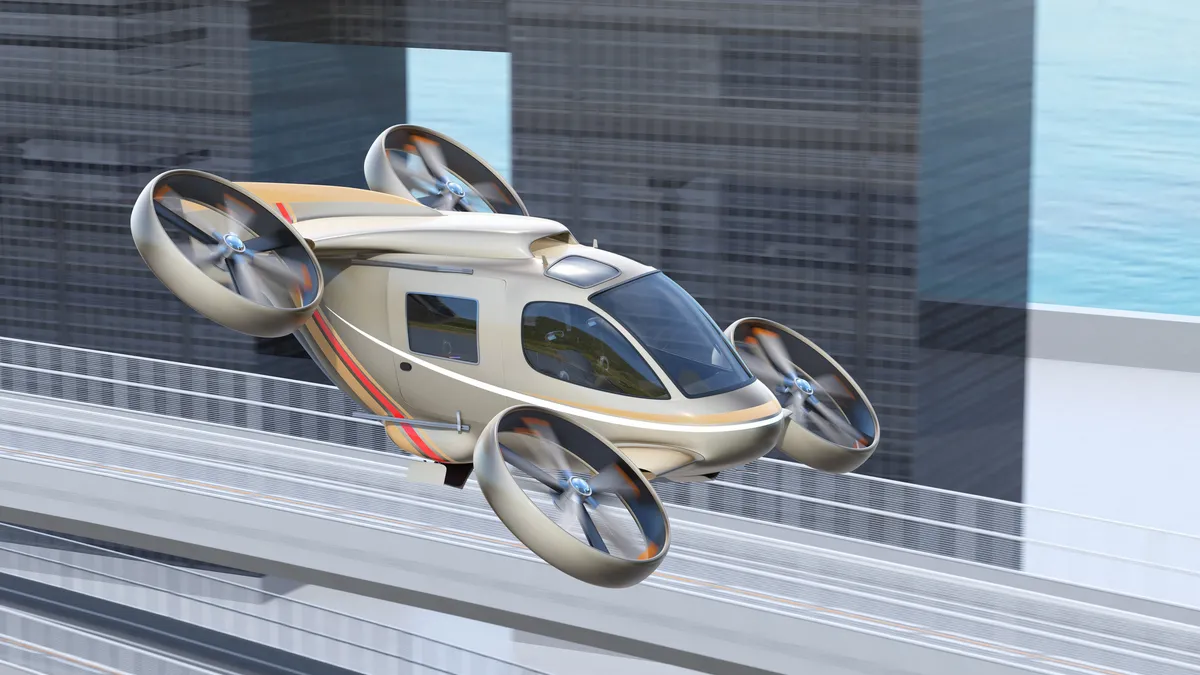Dive Brief:
- Air taxi services from private companies could be operating as soon as 2024, and they could wreak havoc on urban transportation systems if cities do not plan for them, transportation experts said last week during the ITS World Congress in Los Angeles.
- Urban air mobility is more complex than other transportation types, requiring greater communication and coordination among aviation and ground transportation officials, land use planners, vehicle manufacturers, service operators and the public, the experts said.
- Federal regulators have focused most of their attention on approving electric vertical takeoff and landing vehicles, but they have not addressed key policy issues that could affect local and regional transportation systems. "Now we're playing catch up," said Shawn Bullard, CEO of Duetto Group, a consulting and lobbying firm.
Dive Insight:
Miami, Los Angeles, Orlando, Pittsburgh and other U.S. cities have started planning for urban air mobility, but most have not. While that delay could prove challenging as air taxi services begin operating, it is an opportunity to ensure that policies are consistent throughout the U.S. to make rolling out eVTOLs easier, said Suzanne Murtha, vice president of connected and automated vehicle technology at AECOM.
Los Angeles established its policy framework for urban air mobility in September 2021, aiming to improve equity among the city's residents by giving them more ways to get around. The city has worked closely with residents, real estate developers, the Federal Aviation Administration, the California Department of Transportation and other key stakeholders to better understand their needs and communicate its own needs, said Gabriela Juarez, urban air mobility lead for the Los Angeles Department of City Planning.
"While we cannot influence or dictate what another jurisdiction or agency might do with their regulations or their authority, [we can] share our concerns or constraints," Juarez said.
A coordinated approach is a departure from the usual planning process, which typically does not involve much communication between city planners and air transportation authorities. But the complex nature of urban air mobility has made it necessary, speakers said.
Cities may want to locate facilities that allow air taxis to take off and land — called vertiports — alongside airports, railway stations or other existing transportation infrastructure to make it easier for people to switch from one transportation type to another. But that could impact existing transportation systems by, for example, disrupting the air at the airport and making it tougher for airplanes to take off or land, AECOM's Murtha said. The FAA on Monday released its vertiport design standards, addressing crucial considerations such as airspace requirements for approach and departure.
Flying taxis could cause other issues for cities, especially if people use them heavily. For example, skies full of air taxis could block too much sunlight or lead cities to mandate lower building heights, potentially worsening the housing shortage by reducing building density in urban downtowns, Juarez said.
They could also solve important challenges facing cities today, such as managing stadium traffic or filling existing transportation gaps, Juarez said.
While air taxi service providers and aircraft manufacturers have made flying taxis seem inevitable, they are not, said Adam Cohen, senior research manager for the Transportation Sustainability Research Center at the University of California at Berkeley. "The public doesn't have to accept this," Cohen said. "Without the public being OK with something flying over their head, this may not actually fly."
City officials should engage their residents to include their voices in the planning process, these experts said. Without greater community engagement, cities could worsen environmental injustice and social inequity, just as they did with highways and scooters, Juarez said. "We're still trying to dig our way out of it," Juarez said.












